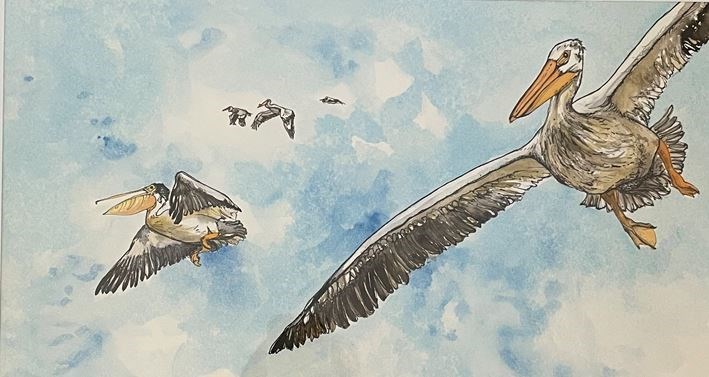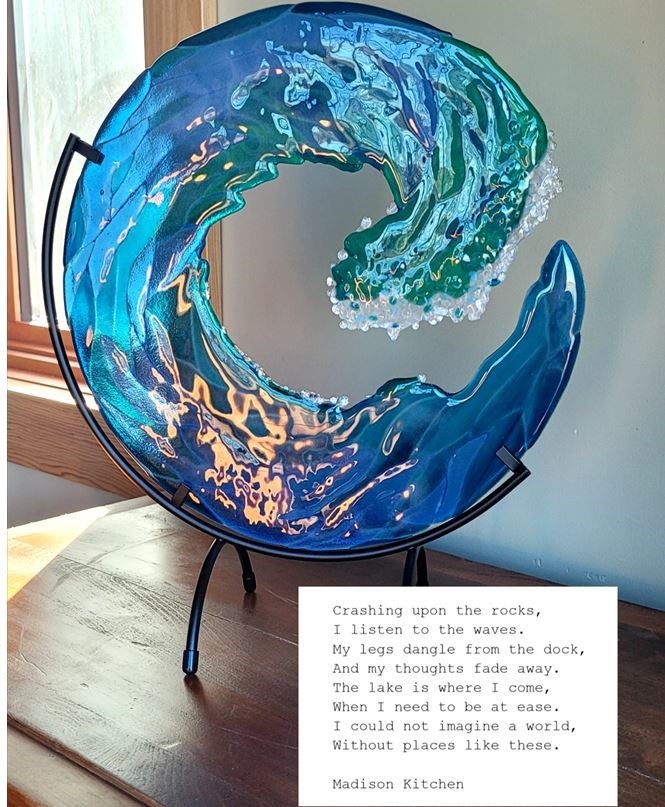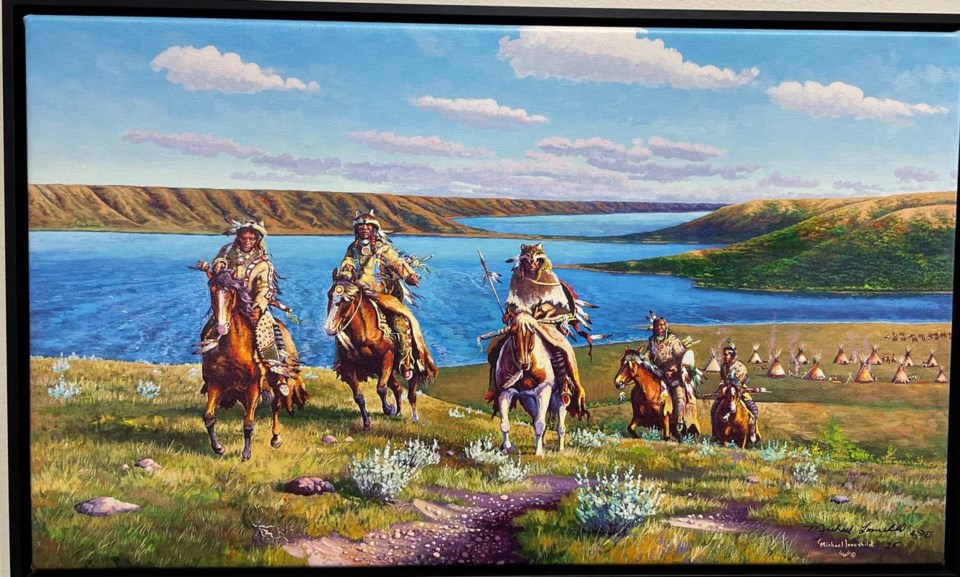QU’APPELLE — The Calling Lakes Ecomuseum is holding a silent auction that will be held from May 3 to May 31 at the Coffee Gallery House on Grand Avenue in Indian Head,
The auction will close on May 31 at 3 p.m.
The Calling Lakes Ecomuseum (CLEM) is a grassroots, community-led initiative working to protect and celebrate the four prairie lakes of the Qu’Appelle Valley: Pasqua, Echo, Mission and Katepwa. The organization’s work brings together people, science and culture to protect these waters for future generations.
CLEM was born out of a crisis that shook our community to its core. On July 1, 2014, 28 beaches in the Qu’Appelle Valley were closed due to dangerously high levels of E. coli. The region had just experienced a stalled rain event that brought significant flooding, and the water was no longer safe. In response, several concerned groups organized a community meeting at the Treaty Four Governance Centre. Dr. Mary Vetters joined and offered her support through a community mapping exercise. That December, her students presented their findings and recommendations — one of which was to form an ecomuseum with the focus on building relationships.
Ecomuseums are grassroots organizations inspired by the United Nations and grounded in the 17 Sustainable Development Goals (SDGs), which include the global commitment to limit global warming to 1.5 C. From the beginning, CLEM has worked closely with the Saskatchewan Regional Centre of Expertise on Education for Sustainable Development, based at the University of Regina.
Through this journey, the organization’s members have come to understand how important eco-tourism is — not just to the economy, but to the stewardship of lands and waters. Places like The Coffee Gallery House are more than just rural businesses; they are living expressions of prairie culture, gathering places for people to dream, connect, and act.
When local artist Andrea Tait generously offered us two original watercolours of the lake and pelicans, we were deeply moved by her kindness. But as members of CLEM, we weren’t sure how best to honor that gift — we’d never fundraised through art before. Over coffee at The Coffee Gallery House with Andrea, Marilyn Malo, and Morganne Cochrane, inspiration struck. That day, in the warmth of the gallery surrounded by art, laughter, and purpose, the idea for a silent auction was born.
It’s amazing how something as simple as a conversation over coffee can turn into something powerful. The Silent Auction was sparked by genuine care for our watershed and awe at the unexpected gifts the prairie continues to offer. These moments remind us that protecting the Qu’Appelle River Basin isn’t just about science or policy — it’s about community, creativity, and believing that even small gestures can ripple outward in big ways.
Good news stories CLEM has been part of:
- Saving Our Water, One Tree at a Time
Since 2021, the volunteers of the Calling Lakes Ecomuseum have proudly walked in both the July 1 Fort Qu’Appelle Lions Parade and the Treaty Four Pow Wow Parade. Each year, we bring along something small, but powerful — tree seedlings, gifted from the Shand Power Station in southern Saskatchewan. As we move along the parade route, our message is simple: "We are trying to save our water — will you help us and plant this tree?"
The response we receive is what fuels us. Parade-goers meet us with gratitude and thank us for caring. And here’s the good news: since we began, we've handed out over 5,000 seedlings.
Each one is a seed of action. A promise of cleaner air, healthier soil, and restored watersheds. And for us, each one is a symbol of partnership — a community coming together to care for the land and water that sustains us all.
- A Beautiful Tree Right in Our Own Backyard
One of the key goals of the Calling Lakes Ecomuseum is to help naturalize the shorelines of our lakes. In our efforts to support this initiative, we reached out to Bill Schroder from Indian Head to explore tree species suited to this work. We discovered that the research station had developed a new variety—the Katepwa Poplar—right here in Saskatchewan. In partnership with the Lower Qu’Appelle Watershed Stewards and U and K Greenhouse, and thanks to secured grant funding, we were able to give away 400 Katepwa Poplar saplings—each about two feet tall at the time.
The good news? Those saplings are now over 20 feet tall and thriving! Not only are they transforming the landscape, but they're also playing a vital role in purifying the water and protecting the health of our lakes. This is a powerful example of what can happen when community, science, and stewardship come together.
- Spring Flood of 2011
The Calling Lakes region experienced a devastating flood. Among the damage was the destruction of a retaining wall made of railway ties at Katepwa Point Provincial Park. The Calling Lakes Ecomuseum (CLEM) saw this as an opportunity to collaborate with the Lower Qu’Appelle Watershed Stewards and Saskatchewan Parks to spark a conversation about child safety during swimming lessons and the potential toxic effects of the chemicals in railway ties. We are proud to share that, as a result of these efforts, the railway ties were permanently removed.
Your Support Matters
Funds raised through this Silent Auction will go directly toward local projects that promote water literacy, shoreline restoration, and ecological conservation. Together, we are protecting the lakes we love.
- Moving the highly saline waters in the Quill Lake Basin to Last Mountain Lake Basin proposal
In 2018, the Quill Lakes Watershed Stewards proposed diverting saline water from the Quill Lakes Basin into the freshwater Qu’Appelle River Basin. In 2017, the Saskatchewan Government determined that the project did not require an Environmental Impact Assessment. In response, the Calling Lakes Ecomuseum (CLEM) organized a Five Pipe Ceremony on November 9, 2017, to pray for the protection of the waters. This spiritual and cultural gathering led to collaboration with Pasqua First Nation and the University of Regina. On May 17, 2018, Pasqua First Nation successfully won a court challenge, preventing the proposed diversion and protecting Last Mountain Lake from saline contamination.
Your Support Matters
Funds raised through this silent auction will go directly toward local projects that promote water literacy, shoreline restoration, and ecological conservation. Together, we are protecting the lakes we love.
- City of Regina and the good work they have done.
Since 2014 CLEM has created discussion with the City of Regina and the University of Regina to help shift the culture around water stewardship—particularly in how treated wastewater is returned to the Qu’Appelle River system. Thanks to sustained collaboration and bold action, the City of Regina has made significant upgrades to its Waste wastewater treatment Plant, far exceeding national standards by drastically reducing harmful nitrates and phosphates in its discharge.
In recognition of this achievement, CLEM proudly presented the City of Regina with a Water Award in 2025—honouring their leadership in protecting water quality and supporting healthier ecosystems across the watershed.
CLEM has received five gifts of art work from the local community.
- Andrea Tait has generously donated two framed original watercolours. Her artwork captures the spirit of hope with soaring birds that remind us just how vital water is to our shared future. You can see more about Andrea’s artwork on her website

- Marilynn Malo has donated an original prairie landscape reimagined in watercolour. She is an acclaimed prairie artist. Her stone houses, weathered barns and farm-inspired still-life works have earned her wide admiration, including a two-year touring show through the Organization of Saskatchewan Arts Councils called Women’s Work and a painting in the Saskatchewan Arts Board’s permanent collection.
- Karen Behnke has generously donated this breathtaking glass sculpture gives life and vibrance to water. The crystal blue form gushes with both the power and the fragility of water. Karen Behnke, a glass artist, lets the fused glass breathe its own ‘larger than life’ essence into each piece. Her bold artistry captures the spirit of water in motion—fluid, fierce, and full of wonder. The poem by her granddaughter also resonates with our community's love for our prairie lakes.

- The Gallery Coffee House has generously donated this limited-edition print of the Qu’Appelle Valley by Micheal Lonechild. This print features a native hunting party, drawing you in with its bouquet of complementary colours. The vivid palette captures the unique energy of the valley—an energy only the Qu’Appelle can offer. This painting is a celebration of our love for this place on earth—prairie love at its finest.





